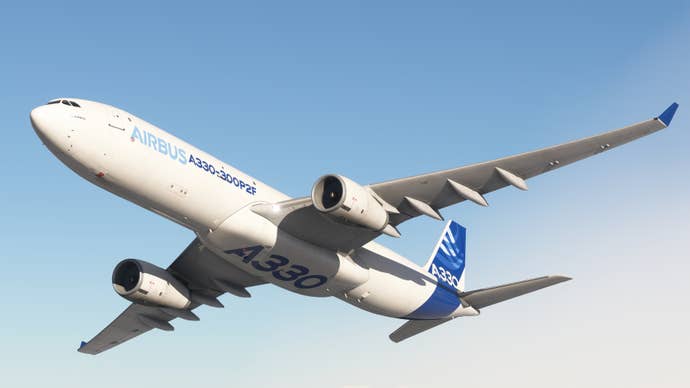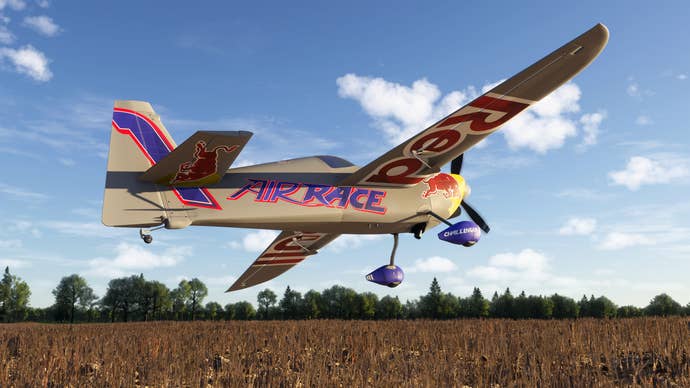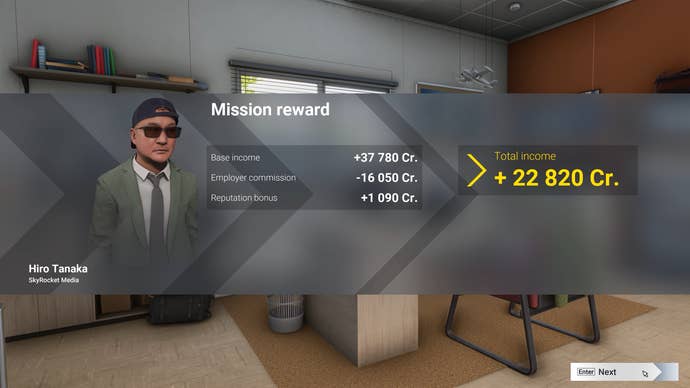Products You May Like
Microsoft Flight Simulator 2024 has a marketing line that sounds like the usual bluster you get around any publisher’s big tentpole game. It is, the publisher and its developers claim, “the most ambitious sim ever undertaken”. I see marketing taglines like that all the time, obviously. I usually filter them out. But this one… it just might be true.
It’s important, then, to analyse that buzzy sentence one more time. They aren’t saying it’s the most ambitious flight simulator ever: they’re saying this is the single most ambitious simulation game ever, be that flight, or trucking, or city management, or farming, or whatever else. It’s a tall order. After spending a day playing the game, I buy it.
An important thing to get out of the way up top is this: there’s a lot more to Flight Simulator 2024 than I expected. Based on the way that it’s been marketed up until now, I thought that it was simply going to be a smattering of smaller improvements, with the main focus being the new career options. On paper, that makes sense. Flight Sim 2020 was a perfectly accomplished simulator, especially after patches – but it also attained a whole new audience of players who wanted more directed content beyond simply flying. Flight Simulator 2024 addresses all of that – and then some.
The reasoning behind the scope is explained as pretty simple – it’s about the game’s audience. The Microsoft Flight Simulator franchise has now served over 45 million players – or simmers, as the developers think of them. That’s across the franchise’s entire 42-year history – but 15 million of those players belonged to Flight Sim 2020. With deep PC penetration – plus versions on Xbox and Streaming – the 2020 game shattered the simulation glass ceiling.
“We didn’t just suddenly invent 10 million new simmers,” says Jörg Neumann, the head of Flight Simulator at Xbox and Microsoft. The truth, he explains, is that the 2020 game found a whole new audience. At their estimation, the player base actually breaks down roughly three ways.
First of all, there’s the core simmers. These are the people who are actually properly into aviation simulation, and they remain the “absolute heart” of everything the team does, Neumann explains. But then there are around another 5 million players that are “typical gamers”, who have come to the franchise for the visual spectacle and as a bit of a novelty. Finally, there’s the “digital tourists” – that is, players lured to Flight Simulator by its impressive ‘digital twin’ copy of the planet, where you can fly over alarmingly accurate representations of the important places in your life, pieced together in-game with satellite imagery.

The aim is to serve all of these users equally – though, as Neumann points out, all three camps did ask for one particular thing universally: more stuff to do. That’s where Flight Simulator’s Career Mode, Activities, and Challenges all come in.
The Challenge mode is simple to approach. You hop into it from the main menu and you’ll be presented with a smorgasbord of challenges for the week. You compete for a score in these mini-missions, and place on a league-based leaderboard with other players around the world. Each challenge can be retried and mastered as many times as you like within the week, allowing you to slowly push up your score. In the hands-on, I try out a difficult fighter pilot route cutting through checkpoints marked throughout the Grand Canyon, and a mission which rewards more points the closer to the ground you can remain while staying stable.
The career is deeper and more about fulfilling your real-life pilot fantasies. Starting out the early stages of the career in my hands-on, I’m impressed. You can choose where you want to start – be that your real life home, your birthplace, a holiday spot, or somewhere you’ve never been. Basically, you start out looking at the Earth as a whole and zoom in to choose a ‘home’ airport. Before that, however, you’ll create a character – the avatar that you’ll see in (and even sometimes outside) the various magnificent vehicles you’ll get to pilot.
The first thing you do in a campaign is meet a flight instructor – and then walk around the plane you’ll be learning in. It gives me vibes of the indulgent ‘Autovista’ mode of Forza Motorsport – except here you can actually make vital pre-flight checks. “If you forget to do something, that’s on you,” Neumann laughs – the preflight walk around is another part of the simulation. From there, you get in and take to the skies on your first flight – and from there, a detailed campaign unfurls.

Across a campaign, you’ll progress through what looks like a typical gaming skill tree, but what are actually various pilot licence qualifications that somewhat mirror those from real life. After getting your initial pilots’ licence, you can then specialise, moving towards something like helicopters, agricultural craft, or airliners – or dabble and do a bit of everything. Unlocking new certifications by taking exams will therefore unlock more content. If you’re a casual, you can take lessons to gradually increase your knowledge. If you’re hardcore, you can hop into the sim and prove that knowledge right off the bat, racking up flight certifications with ease.
It feels strange for such a straight-shot simulation title because it all feels so gamey – but that also feels right and good in the context that Xbox and lead developer Asobo Studio have constructed. There’s a range of activities in the game that goes from things like Search and Rescue to various flavours of Cargo Transport, or from Crop Dusting to VIP Charter Piloting. If you can think of it, it’s probably in – except for anything military-related, something Neumann has highlighted in the past as a red line for MSFS. “There’s a really cool flight combat game out, DCS,” he says. “Why do I have to remake that if you want to play that? You can go play that! We don’t need to be the everything flight sim – I think that would be a mistake.”
Missions relevant to your qualifications pop on the real-life map, and once completed will give you a score which in turn is reflected in a cash reward – with those credits then used to further advance your career. Initially you’ll be working for someone else, who’ll take a cut of your hard-earned cash. Later, you can strike out alone, working up to have a fleet of your own aircraft. Once that’s the case, you’ll want to be careful – things like wear and tear are persistent across your owned aircraft, so if you’re having too many bumpy landings it’ll eat into your bottom line.
Much of this mission structure is AI and computer generated – something sure to cause consternation and debate. There’s a definite argument that the sheer scale of what is on offer here would indeed be impossible to deliver without some automation. It’s an argument I actually agree with to a larger extent – the game’s world is the entire planet, after all. Nevertheless, I get the distinct feeling this really fun game is toying around near a real third rail issue in terms of its use of AI.

Take voice acting, for instance. Because you can start anywhere in the world, the voice of that first instructor you meet and subsequent career encounters are all computer-generated, allowing the game to respond and accurately name the exact location and situation you’re in, even though there’s thousands that you can choose from. Even the weather, imported from the real world, can have an effect. Missions are much the same – populated on the map by AI, machine learning, and so on. Almost everything from voicework to the exact parameters of the mission has some degree of automation to it – which is how the planet has ended up populated with millions of bits of busy work to attempt.
“There’s three million missions, and most of the missions are parameterized,” Neumann explains. “Like, often we have no idea where this stuff actually happens. Let’s say you want to be crop dusting in Thailand, I have no idea. I’ve never been to Thailand – but the system has to handle it.”
When you think about it, it’s all a pretty staggering use of all the data that has been compiled for this game. In Neumann’s example, Bing Maps data gets cross-referenced with things like records of airfields and helipads, the map imaging automatically analysed to identify the real-life fields that could work well enough for crop dusting that are in a reasonable range of an appropriate take off and landing strip for the required type of aircraft for the task. Based on that, the game generates missions of every stripe that make sense in every bit of the world. The scale is mind-boggling; even early on, before unlocking many missions, you can zoom out the world map and feel overwhelmed with the options.
In addition to the parameterized, generated content there’s a handful of hand-curated things – including ‘World Photographer’, a bucket list of photos around the world where you’re tasked with snapping things like wildlife (with character models that have amusingly been borrowed, with permission, from Frontier’s Planet Zoo) or world landmarks. Developers describe this mode as a teaching tool as well as an activity. You can snap photos from any mode (ie mid-career, in free flight, or even in challenges), or even warp directly to the exact location of a photo from the World Traveller menu. But it’ll be up to you to competently fly to an appropriate position to snap the photo, or use the in-game tools to set the correct time of day, weather, and so on. In this, even the photo mode is a gentle inducement to entice players from casual tomfoolery to fully engaging with the simulator.

The idea is to ensure the world feels to some extent as populated as real life – and also to ensure that no matter how you play this sandbox campaign, there’ll never be a shortage of activities. If you want to stay close to your home airport, or perhaps never leave your home country, you theoretically will still never run out of missions. Those who want to globetrot fully will obviously have an even greater variety of things to see and do.
Like I said, that’s the one thing that all three categories of players asked for. I think all three will be satisfied. I count myself as more in the gamer category, but with a deep appreciation for sims (my big sim obsession was Microsoft Train Simulator – which I’d love to see return). Where Flight Sim 2020 proved a cool toy that I’d boot and fiddle with to see the world, take in graphical spectacle, or minorly nerd out about aviation, I can see more of a game here. I can see a design that could hook me in. In that, this seems like a mission accomplished.
For the more harcore players, obviously, there’s a laundry list of exciting new additions besides. As well as being the most ambitious, the developers make clear that they want to be “the most accurate consumer sim ever”. There’s endless stuff here that is far too heavy to get into on VG247, but I can offer up a few crumbs that piqued my interest.
We’re shown incredible graphs and annotated simulation footage showing how various aspects of the actual sim bit of the sim have improved. I see a German journalist, who writes for a flight-specific outlet, hyperventilate with glee at the reveal that there’s now five times more surface aerodynamics simulation (that is, how air flows over the plane in flight) than in the previous game. Updates like this also mean that much more complex shapes of aircraft can now be supported – something both the developers and modders will be able to exploit over the life of the game.

I’m personally grabbed by talk of realistic soft body simulation – which isn’t as sexy as it sounds, since it’s about things like tissue, rope, and similar materials. This is handy for Hot Air Balloons, but also for things like aerial advertisement tasks in the career – you can finally drag a banner above Palm Beach and watch it flap in uber-realistic physics, if that’s your cup of tea.
The last exciting thing for the core, and curious for the rest of us, is best shown off in avionics. These are the systems you get in planes – the little screens built into the cockpit, or the iPad-like devices pilots use to chart a course and stay on top of the data. What’s been done here is demonstrative of a wider shift in approach in the game’s development – and that’s bringing in outside developers to assist.
Working Title Simulations, for instance, is a small third-party team that started out creating premium mods for previous Flight Simulator titles. This time, they’re inside the tent, working hand-in-hand with Microsoft and Asobo to deliver hyper-realistic avionics systems both for in-flight and pre-flight. These guys are carefully recreating systems built by real-life companies like Garmin, and are at the point where they’re not just simulating the software, but also the satellites in the upper atmosphere those systems ping off of. They’re one of 25 different companies that has been drafted in to help, making the jump from fan modders submitting to the game’s marketplace to true partners with the developers.
Each of the partners has expertise in different fields and different aspects of the simulation – which helps to allow for the astonishing breadth I saw on display in my one-day preview. Flight Simulator 2024’s new Gliders are designed by a team that got its start making gliders as unofficial add-ons – now they’ve been drafted in to get them into the game proper.

“This is a fundamental shift in how the product is built,” Neumann preaches. It’s not just for the community, he goes on to explain – this time, it is built with the community.
In line with that, support for modders remains key, too. FS 2020 is closing in on 5000 mods available on the official marketplace – 2024 will support them all, but also has engine support for tens of thousands of add-ons.
All of this has been said without getting into the smaller changes. There’s a much higher level of ground detail, there’s way more planes and choppers by default and ongoing support for the hundreds of existing user-made additions. Countless simulator improvements. A more browsable marketplace. Most welcome, the ‘Light Client’, which puts more assets in the cloud and dramatically reduces the amount of data required on your hard drive to play.
I don’t know what the opposite of ‘Death by a Thousand Cuts’ is, but Flight Simulator 2024 feels like it’s that. It’s a lot of little things – and a couple of big things – that add up to make this look like it’s going to be a really significantly better version of one of the best games of 2020; one of those games that kept us sane through lockdown.
Back then, it was the perfect time for ‘digital tourism’ – we were all trapped inside, after all. The question was always going to be if the next game could keep those people around, as well as continue to satisfy the core simulation audience. Even a day with the 2024 edition makes clear that this is a bigger, better, and wildly ambitious game. All the pieces are clearly in place to not just keep the audience around, but grow it further still.
This is certainly the biggest-ever Flight Simulator release in terms of content – it may also be in terms of audience. We’ll see if the stars truly align in November.
